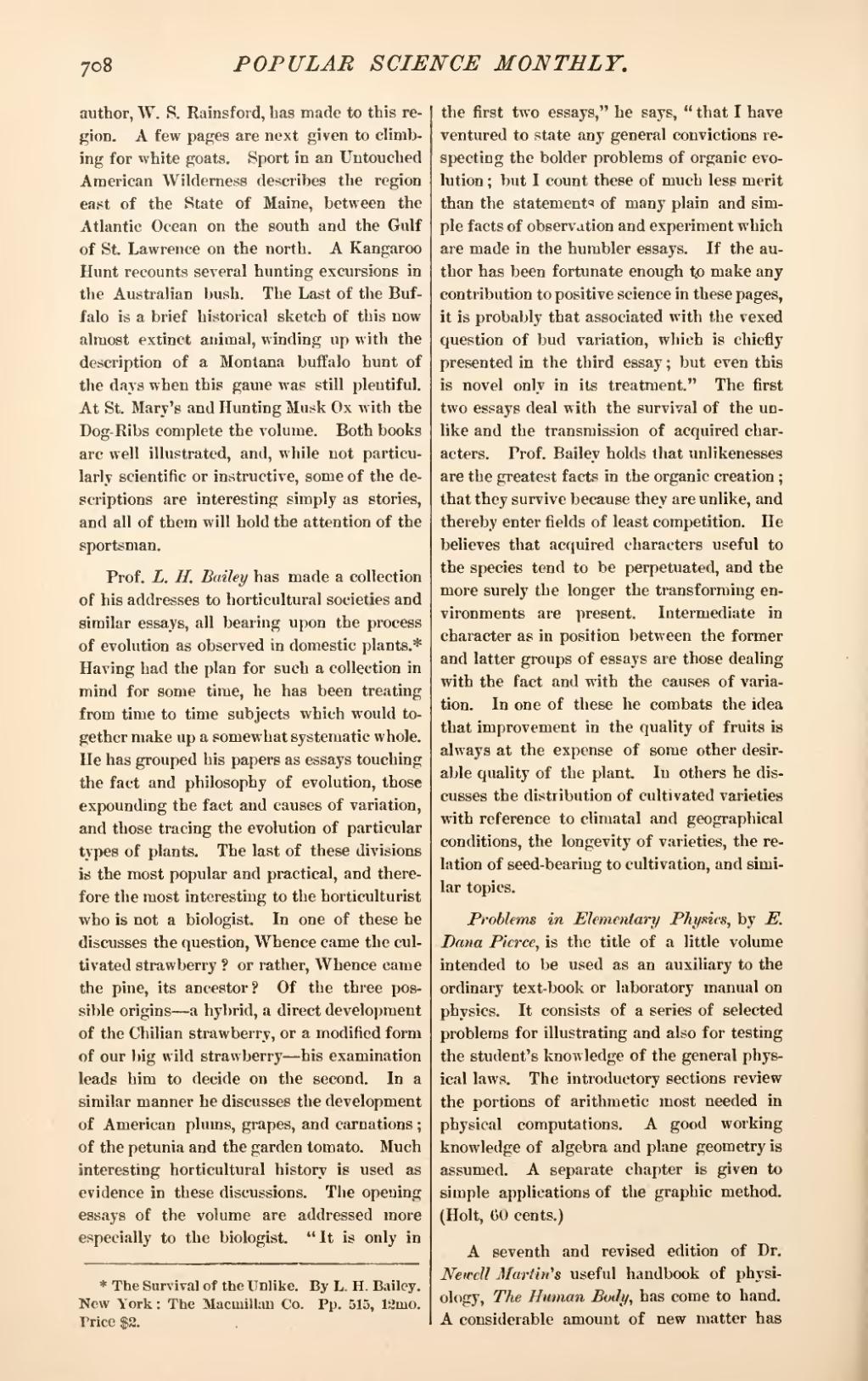author, W. S. Rainsford, has made to this region. A few pages are next given to climbing for white goats. Sport in an Untouched American Wilderness describes the region east of the State of Maine, between the Atlantic Ocean on the south and the Gulf of St. Lawrence on the north. A Kangaroo Hunt recounts several hunting excursions in the Australian bush. The Last of the Buffalo is a brief historical sketch of this now almost extinct animal, winding up with the description of a Montana buffalo hunt of the days when this game was still plentiful. At St. Mary's and Hunting Musk Ox with the Dog-Ribs complete the volume. Both books are well illustrated, and, while not particularly scientific or instructive, some of the descriptions are interesting simply as stories, and all of them will hold the attention of the sportsman.
Prof. L. H. Bailey has made a collection of his addresses to horticultural societies and similar essays, all bearing upon the process of evolution as observed in domestic plants.[1]Having had the plan for such a collection in mind for some time, he has been treating from time to time subjects which would together make up a somewhat systematic whole. He has grouped his papers as essays touching the fact and philosophy of evolution, those expounding the fact and causes of variation, and those tracing the evolution of particular types of plants. The last of these divisions is the most popular and practical, and therefore the most interesting to the horticulturist who is not a biologist. In one of these he discusses the question, Whence came the cultivated strawberry? or rather. Whence came the pine, its ancestor? Of the three possible origins—a hybrid, a direct development of the Chilian strawberry, or a modified form of our big wild strawberry—his examination leads him to decide on the second. In a similar manner he discusses the development of American plums, grapes, and carnations; of the petunia and the garden tomato. Much interesting horticultural history is used as evidence in these discussions. The opening essays of the volume are addressed more especially to the biologist. "It is only in the first two essays," he says, "that I have ventured to state any general convictions respecting the bolder problems of organic evolution; but I count these of much less merit than the statements of many plain and simple facts of observation and experiment which are made in the humbler essays. If the author has been fortunate enough t.o make any contribution to positive science in these pages, it is probably that associated with the vexed question of bud variation, which is chiefly presented in the third essay; but even this is novel only in its treatment." The first two essays deal with the survival of the unlike and the transmission of acquired characters. Prof. Bailey holds that unlikenesses are the greatest facts in the organic creation; that they survive because they are unlike, and thereby enter fields of least competition. He believes that acquired characters useful to the species tend to be perpetuated, and the more surely the longer the transforming environments are present. Intermediate in character as in position between the former and latter groups of essays are those dealing with the fact and with the causes of variation. In one of these he combats the idea that improvement in the quality of fruits is always at the expense of some other desirable quality of the plant. In others he discusses the distribution of cultivated varieties with reference to climatal and geographical conditions, the longevity of varieties, the relation of seed-bearing to cultivation, and similar topics.
Problems in Elementary Physics, by E. Dana Pierce, is the title of a little volume intended to be used as an auxiliary to the ordinary text-book or laboratory manual on physics. It consists of a series of selected problems for illustrating and also for testing the student's knowledge of the general physical laws. The introductory sections review the portions of arithmetic most needed in physical computations. A good working knowledge of algebra and plane geometry is assumed. A separate chapter is given to simple applications of the graphic method. (Holt, 60 cents.)
A seventh and revised edition of Dr. Newell Martin's useful handbook of physiology, The Human Body, has come to hand. A considerable amount of new matter has
- ↑ The Survival of the Unlike. By L.H. Bailey. New York: The Macmillan Co. Pp. 515, 12mo. Price $2.
